Corporate Accounting: Recoverable Amounts and Asset Impairment Review
VerifiedAdded on 2023/06/11
|6
|1483
|472
Essay
AI Summary
This essay provides an overview of asset impairment in corporate accounting, focusing on the determination of recoverable amounts as per International Accounting Standard 136 and AASB 136. It discusses the concepts of fair value less cost of disposal and value in use, explaining how these values are used to identify and measure asset impairment. The recoverable amount is defined as the higher of an asset's fair value less costs of disposal and its value in use. The essay emphasizes the importance of accurately determining these values to ensure that assets are not carried at amounts exceeding their recoverable value, with any impairment loss being recognized in the company's income statement. It also highlights the methodologies for estimating future cash flows and appropriate discount rates for calculating the value in use, as well as the considerations for determining fair value in the absence of an active market. Desklib provides a platform for students to access this document and other solved assignments.
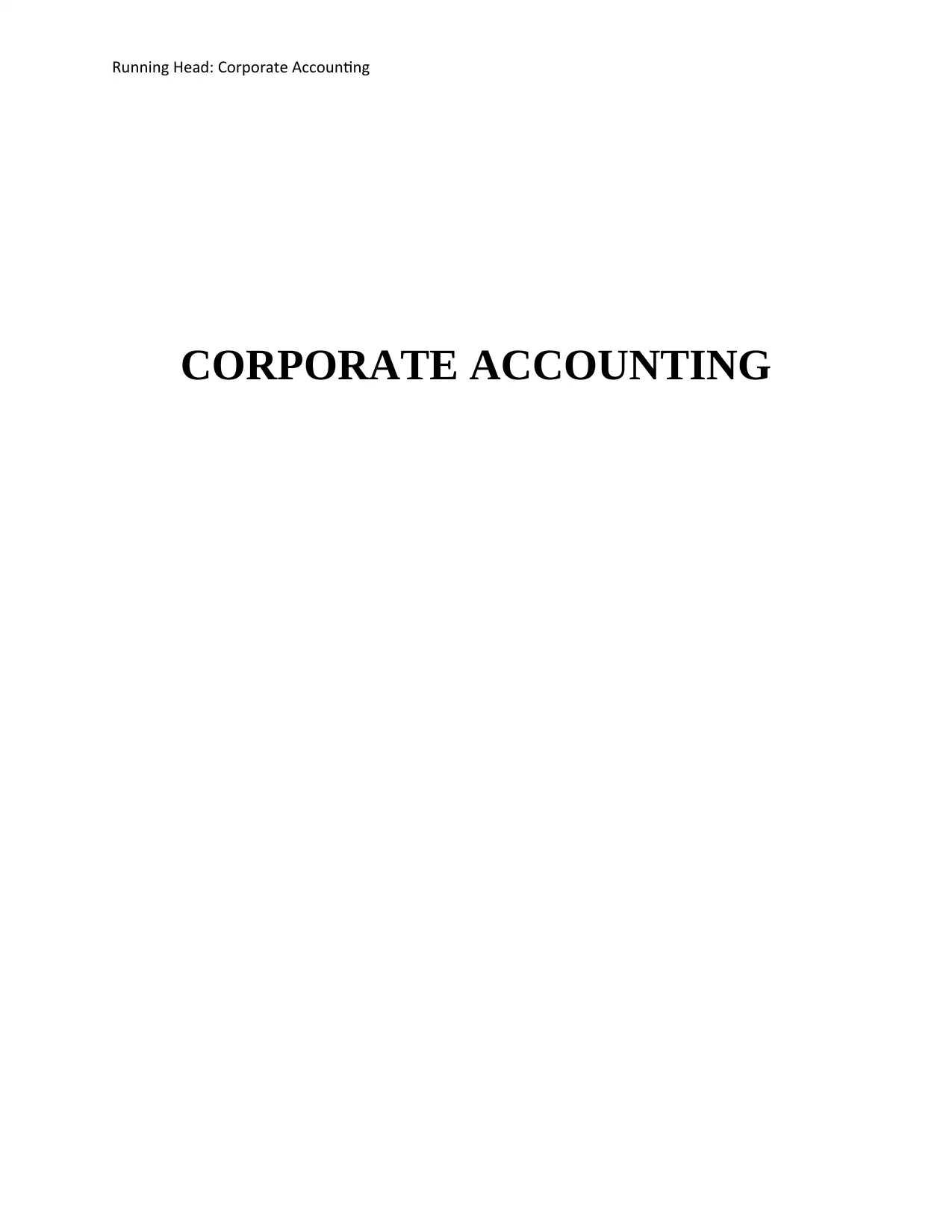
Running Head: Corporate Accounting
CORPORATE ACCOUNTING
CORPORATE ACCOUNTING
Paraphrase This Document
Need a fresh take? Get an instant paraphrase of this document with our AI Paraphraser
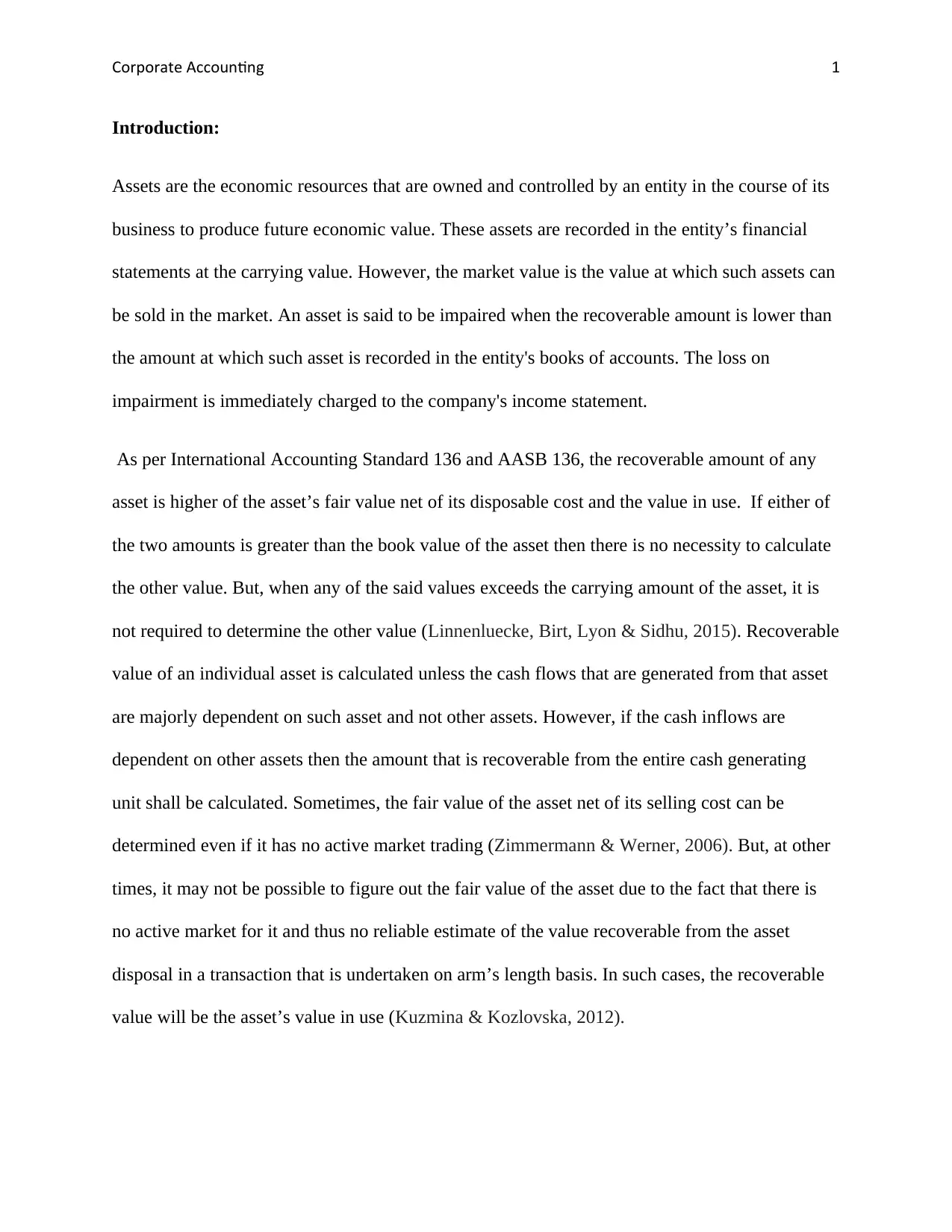
Corporate Accounting 1
Introduction:
Assets are the economic resources that are owned and controlled by an entity in the course of its
business to produce future economic value. These assets are recorded in the entity’s financial
statements at the carrying value. However, the market value is the value at which such assets can
be sold in the market. An asset is said to be impaired when the recoverable amount is lower than
the amount at which such asset is recorded in the entity's books of accounts. The loss on
impairment is immediately charged to the company's income statement.
As per International Accounting Standard 136 and AASB 136, the recoverable amount of any
asset is higher of the asset’s fair value net of its disposable cost and the value in use. If either of
the two amounts is greater than the book value of the asset then there is no necessity to calculate
the other value. But, when any of the said values exceeds the carrying amount of the asset, it is
not required to determine the other value (Linnenluecke, Birt, Lyon & Sidhu, 2015). Recoverable
value of an individual asset is calculated unless the cash flows that are generated from that asset
are majorly dependent on such asset and not other assets. However, if the cash inflows are
dependent on other assets then the amount that is recoverable from the entire cash generating
unit shall be calculated. Sometimes, the fair value of the asset net of its selling cost can be
determined even if it has no active market trading (Zimmermann & Werner, 2006). But, at other
times, it may not be possible to figure out the fair value of the asset due to the fact that there is
no active market for it and thus no reliable estimate of the value recoverable from the asset
disposal in a transaction that is undertaken on arm’s length basis. In such cases, the recoverable
value will be the asset’s value in use (Kuzmina & Kozlovska, 2012).
Introduction:
Assets are the economic resources that are owned and controlled by an entity in the course of its
business to produce future economic value. These assets are recorded in the entity’s financial
statements at the carrying value. However, the market value is the value at which such assets can
be sold in the market. An asset is said to be impaired when the recoverable amount is lower than
the amount at which such asset is recorded in the entity's books of accounts. The loss on
impairment is immediately charged to the company's income statement.
As per International Accounting Standard 136 and AASB 136, the recoverable amount of any
asset is higher of the asset’s fair value net of its disposable cost and the value in use. If either of
the two amounts is greater than the book value of the asset then there is no necessity to calculate
the other value. But, when any of the said values exceeds the carrying amount of the asset, it is
not required to determine the other value (Linnenluecke, Birt, Lyon & Sidhu, 2015). Recoverable
value of an individual asset is calculated unless the cash flows that are generated from that asset
are majorly dependent on such asset and not other assets. However, if the cash inflows are
dependent on other assets then the amount that is recoverable from the entire cash generating
unit shall be calculated. Sometimes, the fair value of the asset net of its selling cost can be
determined even if it has no active market trading (Zimmermann & Werner, 2006). But, at other
times, it may not be possible to figure out the fair value of the asset due to the fact that there is
no active market for it and thus no reliable estimate of the value recoverable from the asset
disposal in a transaction that is undertaken on arm’s length basis. In such cases, the recoverable
value will be the asset’s value in use (Kuzmina & Kozlovska, 2012).
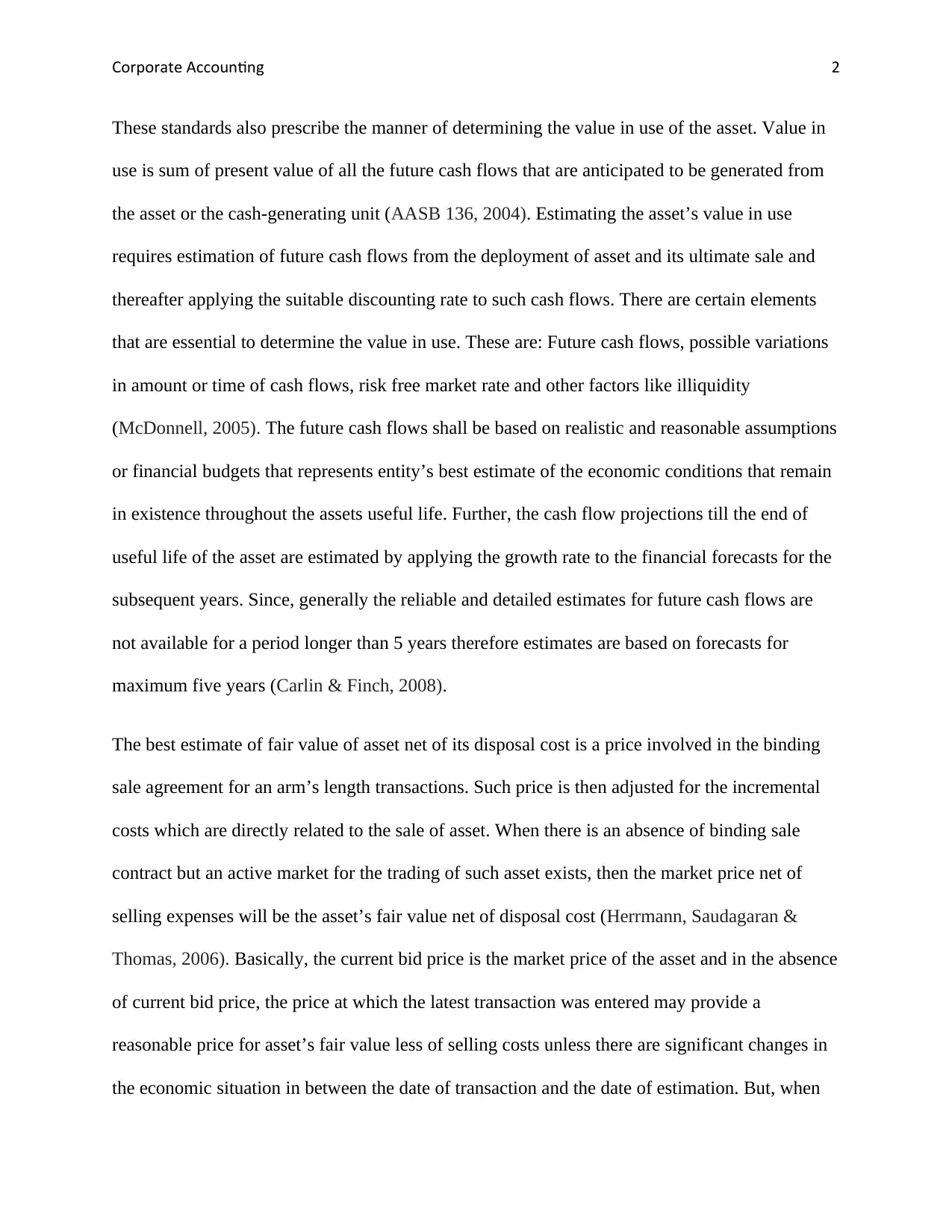
Corporate Accounting 2
These standards also prescribe the manner of determining the value in use of the asset. Value in
use is sum of present value of all the future cash flows that are anticipated to be generated from
the asset or the cash-generating unit (AASB 136, 2004). Estimating the asset’s value in use
requires estimation of future cash flows from the deployment of asset and its ultimate sale and
thereafter applying the suitable discounting rate to such cash flows. There are certain elements
that are essential to determine the value in use. These are: Future cash flows, possible variations
in amount or time of cash flows, risk free market rate and other factors like illiquidity
(McDonnell, 2005). The future cash flows shall be based on realistic and reasonable assumptions
or financial budgets that represents entity’s best estimate of the economic conditions that remain
in existence throughout the assets useful life. Further, the cash flow projections till the end of
useful life of the asset are estimated by applying the growth rate to the financial forecasts for the
subsequent years. Since, generally the reliable and detailed estimates for future cash flows are
not available for a period longer than 5 years therefore estimates are based on forecasts for
maximum five years (Carlin & Finch, 2008).
The best estimate of fair value of asset net of its disposal cost is a price involved in the binding
sale agreement for an arm’s length transactions. Such price is then adjusted for the incremental
costs which are directly related to the sale of asset. When there is an absence of binding sale
contract but an active market for the trading of such asset exists, then the market price net of
selling expenses will be the asset’s fair value net of disposal cost (Herrmann, Saudagaran &
Thomas, 2006). Basically, the current bid price is the market price of the asset and in the absence
of current bid price, the price at which the latest transaction was entered may provide a
reasonable price for asset’s fair value less of selling costs unless there are significant changes in
the economic situation in between the date of transaction and the date of estimation. But, when
These standards also prescribe the manner of determining the value in use of the asset. Value in
use is sum of present value of all the future cash flows that are anticipated to be generated from
the asset or the cash-generating unit (AASB 136, 2004). Estimating the asset’s value in use
requires estimation of future cash flows from the deployment of asset and its ultimate sale and
thereafter applying the suitable discounting rate to such cash flows. There are certain elements
that are essential to determine the value in use. These are: Future cash flows, possible variations
in amount or time of cash flows, risk free market rate and other factors like illiquidity
(McDonnell, 2005). The future cash flows shall be based on realistic and reasonable assumptions
or financial budgets that represents entity’s best estimate of the economic conditions that remain
in existence throughout the assets useful life. Further, the cash flow projections till the end of
useful life of the asset are estimated by applying the growth rate to the financial forecasts for the
subsequent years. Since, generally the reliable and detailed estimates for future cash flows are
not available for a period longer than 5 years therefore estimates are based on forecasts for
maximum five years (Carlin & Finch, 2008).
The best estimate of fair value of asset net of its disposal cost is a price involved in the binding
sale agreement for an arm’s length transactions. Such price is then adjusted for the incremental
costs which are directly related to the sale of asset. When there is an absence of binding sale
contract but an active market for the trading of such asset exists, then the market price net of
selling expenses will be the asset’s fair value net of disposal cost (Herrmann, Saudagaran &
Thomas, 2006). Basically, the current bid price is the market price of the asset and in the absence
of current bid price, the price at which the latest transaction was entered may provide a
reasonable price for asset’s fair value less of selling costs unless there are significant changes in
the economic situation in between the date of transaction and the date of estimation. But, when
⊘ This is a preview!⊘
Do you want full access?
Subscribe today to unlock all pages.

Trusted by 1+ million students worldwide
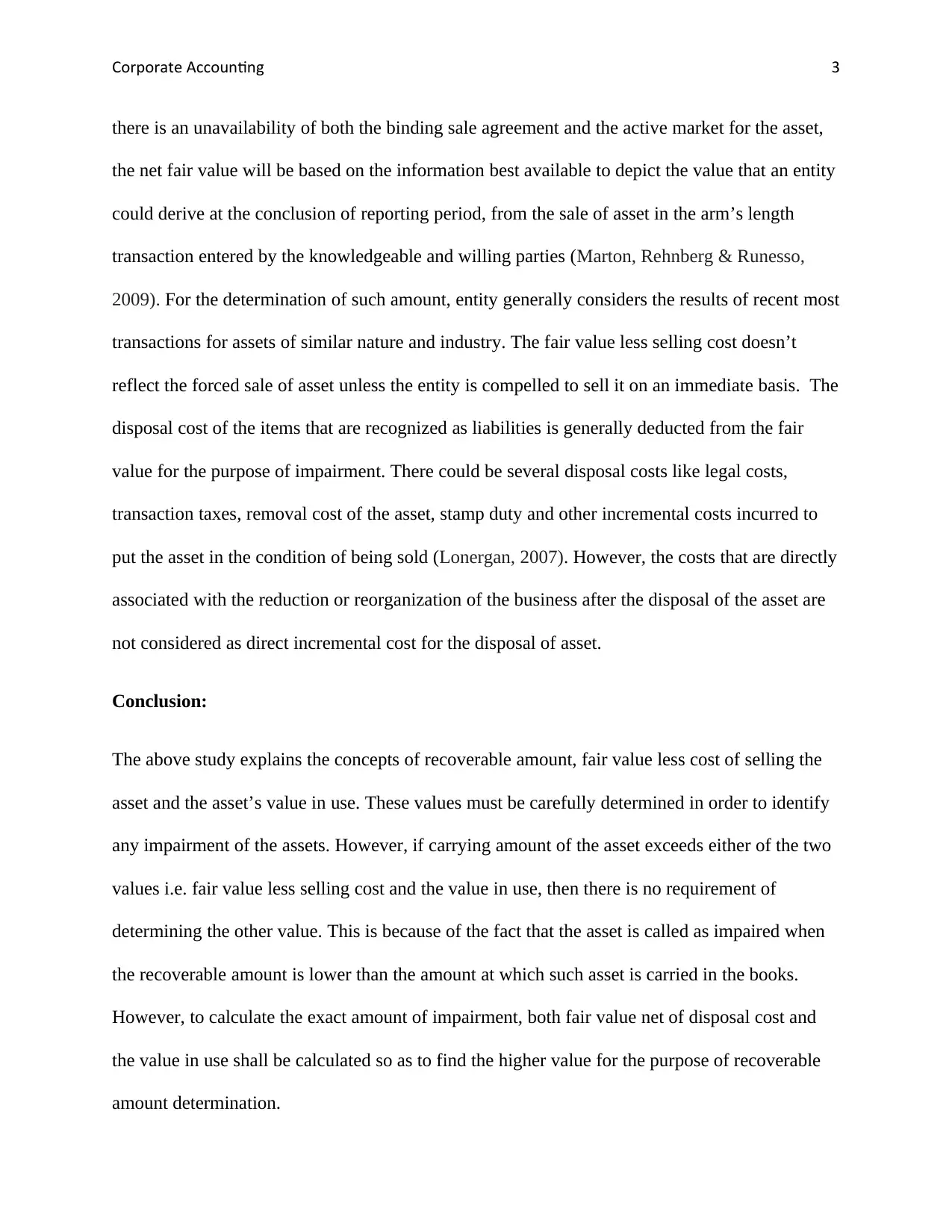
Corporate Accounting 3
there is an unavailability of both the binding sale agreement and the active market for the asset,
the net fair value will be based on the information best available to depict the value that an entity
could derive at the conclusion of reporting period, from the sale of asset in the arm’s length
transaction entered by the knowledgeable and willing parties (Marton, Rehnberg & Runesso,
2009). For the determination of such amount, entity generally considers the results of recent most
transactions for assets of similar nature and industry. The fair value less selling cost doesn’t
reflect the forced sale of asset unless the entity is compelled to sell it on an immediate basis. The
disposal cost of the items that are recognized as liabilities is generally deducted from the fair
value for the purpose of impairment. There could be several disposal costs like legal costs,
transaction taxes, removal cost of the asset, stamp duty and other incremental costs incurred to
put the asset in the condition of being sold (Lonergan, 2007). However, the costs that are directly
associated with the reduction or reorganization of the business after the disposal of the asset are
not considered as direct incremental cost for the disposal of asset.
Conclusion:
The above study explains the concepts of recoverable amount, fair value less cost of selling the
asset and the asset’s value in use. These values must be carefully determined in order to identify
any impairment of the assets. However, if carrying amount of the asset exceeds either of the two
values i.e. fair value less selling cost and the value in use, then there is no requirement of
determining the other value. This is because of the fact that the asset is called as impaired when
the recoverable amount is lower than the amount at which such asset is carried in the books.
However, to calculate the exact amount of impairment, both fair value net of disposal cost and
the value in use shall be calculated so as to find the higher value for the purpose of recoverable
amount determination.
there is an unavailability of both the binding sale agreement and the active market for the asset,
the net fair value will be based on the information best available to depict the value that an entity
could derive at the conclusion of reporting period, from the sale of asset in the arm’s length
transaction entered by the knowledgeable and willing parties (Marton, Rehnberg & Runesso,
2009). For the determination of such amount, entity generally considers the results of recent most
transactions for assets of similar nature and industry. The fair value less selling cost doesn’t
reflect the forced sale of asset unless the entity is compelled to sell it on an immediate basis. The
disposal cost of the items that are recognized as liabilities is generally deducted from the fair
value for the purpose of impairment. There could be several disposal costs like legal costs,
transaction taxes, removal cost of the asset, stamp duty and other incremental costs incurred to
put the asset in the condition of being sold (Lonergan, 2007). However, the costs that are directly
associated with the reduction or reorganization of the business after the disposal of the asset are
not considered as direct incremental cost for the disposal of asset.
Conclusion:
The above study explains the concepts of recoverable amount, fair value less cost of selling the
asset and the asset’s value in use. These values must be carefully determined in order to identify
any impairment of the assets. However, if carrying amount of the asset exceeds either of the two
values i.e. fair value less selling cost and the value in use, then there is no requirement of
determining the other value. This is because of the fact that the asset is called as impaired when
the recoverable amount is lower than the amount at which such asset is carried in the books.
However, to calculate the exact amount of impairment, both fair value net of disposal cost and
the value in use shall be calculated so as to find the higher value for the purpose of recoverable
amount determination.
Paraphrase This Document
Need a fresh take? Get an instant paraphrase of this document with our AI Paraphraser

Corporate Accounting 4
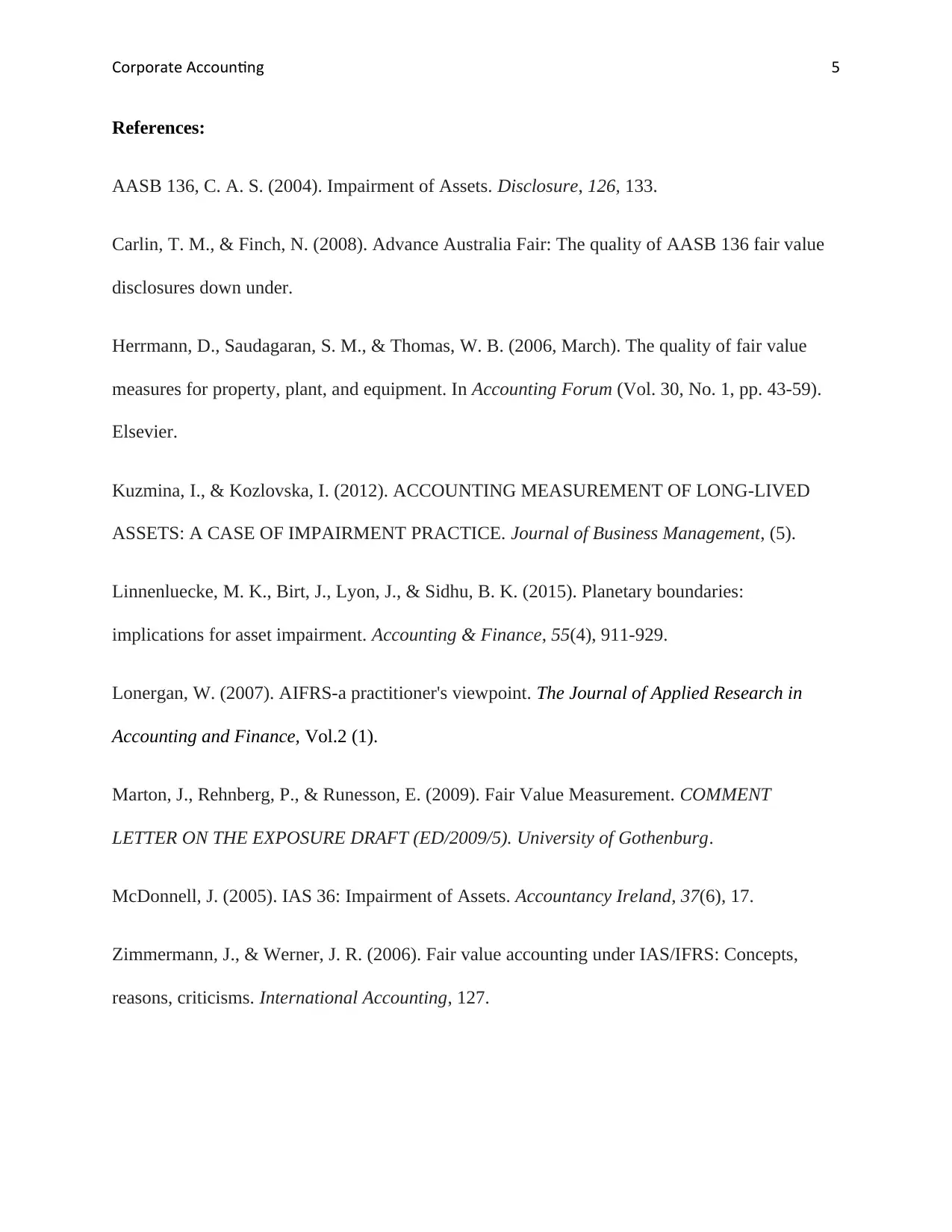
Corporate Accounting 5
References:
AASB 136, C. A. S. (2004). Impairment of Assets. Disclosure, 126, 133.
Carlin, T. M., & Finch, N. (2008). Advance Australia Fair: The quality of AASB 136 fair value
disclosures down under.
Herrmann, D., Saudagaran, S. M., & Thomas, W. B. (2006, March). The quality of fair value
measures for property, plant, and equipment. In Accounting Forum (Vol. 30, No. 1, pp. 43-59).
Elsevier.
Kuzmina, I., & Kozlovska, I. (2012). ACCOUNTING MEASUREMENT OF LONG-LIVED
ASSETS: A CASE OF IMPAIRMENT PRACTICE. Journal of Business Management, (5).
Linnenluecke, M. K., Birt, J., Lyon, J., & Sidhu, B. K. (2015). Planetary boundaries:
implications for asset impairment. Accounting & Finance, 55(4), 911-929.
Lonergan, W. (2007). AIFRS-a practitioner's viewpoint. The Journal of Applied Research in
Accounting and Finance, Vol.2 (1).
Marton, J., Rehnberg, P., & Runesson, E. (2009). Fair Value Measurement. COMMENT
LETTER ON THE EXPOSURE DRAFT (ED/2009/5). University of Gothenburg.
McDonnell, J. (2005). IAS 36: Impairment of Assets. Accountancy Ireland, 37(6), 17.
Zimmermann, J., & Werner, J. R. (2006). Fair value accounting under IAS/IFRS: Concepts,
reasons, criticisms. International Accounting, 127.
References:
AASB 136, C. A. S. (2004). Impairment of Assets. Disclosure, 126, 133.
Carlin, T. M., & Finch, N. (2008). Advance Australia Fair: The quality of AASB 136 fair value
disclosures down under.
Herrmann, D., Saudagaran, S. M., & Thomas, W. B. (2006, March). The quality of fair value
measures for property, plant, and equipment. In Accounting Forum (Vol. 30, No. 1, pp. 43-59).
Elsevier.
Kuzmina, I., & Kozlovska, I. (2012). ACCOUNTING MEASUREMENT OF LONG-LIVED
ASSETS: A CASE OF IMPAIRMENT PRACTICE. Journal of Business Management, (5).
Linnenluecke, M. K., Birt, J., Lyon, J., & Sidhu, B. K. (2015). Planetary boundaries:
implications for asset impairment. Accounting & Finance, 55(4), 911-929.
Lonergan, W. (2007). AIFRS-a practitioner's viewpoint. The Journal of Applied Research in
Accounting and Finance, Vol.2 (1).
Marton, J., Rehnberg, P., & Runesson, E. (2009). Fair Value Measurement. COMMENT
LETTER ON THE EXPOSURE DRAFT (ED/2009/5). University of Gothenburg.
McDonnell, J. (2005). IAS 36: Impairment of Assets. Accountancy Ireland, 37(6), 17.
Zimmermann, J., & Werner, J. R. (2006). Fair value accounting under IAS/IFRS: Concepts,
reasons, criticisms. International Accounting, 127.
⊘ This is a preview!⊘
Do you want full access?
Subscribe today to unlock all pages.

Trusted by 1+ million students worldwide
1 out of 6
Related Documents
Your All-in-One AI-Powered Toolkit for Academic Success.
+13062052269
info@desklib.com
Available 24*7 on WhatsApp / Email
![[object Object]](/_next/static/media/star-bottom.7253800d.svg)
Unlock your academic potential
Copyright © 2020–2025 A2Z Services. All Rights Reserved. Developed and managed by ZUCOL.





